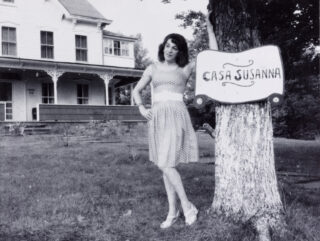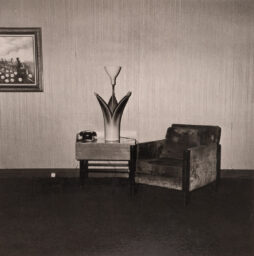Memories of the African Diaspora: A Conversation with Nicola Lo Calzo
Since 2010, the Italian photographer Nicola Lo Calzo has traversed the Atlantic coasts to research buried memories of the African Diaspora. His latest installment, Regla, taken in Cuba, is the sixth and last chapter in an album entitled Cham, following series in West Africa, Guadeloupe, Haiti, the southern United States, French Guyana, and Suriname, each of which set the stage for photographic journeys through history. Mixing documentary and art photography, Regla reveals a society’s solidarity and resistance to oppression. I spoke with Lo Calzo in advance of his exhibition of Regla, currently on view at the fourth edition of the PORTRAIT(S) festival in Vichy, France. —Yves Chatap

Nicola Lo Calzo, Reinier, Sibooney Beach, Santiago, 2015. Courtesy the artist and L’agence à Paris
Yves Chatap: In the introductory text to your series Regla, you write, “There are two Cubas . . . ” What do you mean by this?
Nicola Lo Calzo: This idea of “two Cubas “comes from a desire to report on another story about a country that is often sidelined by the revolutionary story. For example, in Cuba, there is a form of negotiated freedom governed by religious and secular rituals. At the time of Spanish colonization, African descendants developed spaces of emancipation which are now owned by the majority of Cubans. Despite the complex socioeconomic and political developments that have animated Cuba since the beginning of the communist revolution, all of these practices have retained their original functions. In all the groups that I photographed, such as the masons, the Abakuá secret society, the families of Santeria, the Cabildos de Nacione Africana, and the hip-hop community, there are strong links of solidarity and mutual assistance that have persisted since the creation of Afro-Cuban communities during the time when the country was still a colony.

Nicola Lo Calzo, The Sacred Chalice with medicinal plants used to purify the places and the people present at the Abakuá ceremony, Erionda Efo secret society, Regla, 2016. Courtesy the artist and L’agence à Paris
Chatap: How does this new series connect with your work from the series Casta, which focused on the southern United States?
Lo Calzo: The series Regla and Casta are both part of my long-term project on African heritage and memories of slavery in the Atlantic world, which I began in 2010. In Casta, I turned my eyes to the legacy of slavery during the antebellum period in Louisiana and Mississippi, and focused on the different ways local communities have been re-appropriating the past. While in Cuba, I explored some of the existing Afro-Cuban cultural practices, developed during that country’s slave era. Within these religious or secular practices, the Cuban—irrespective of color or political affiliation and far from the revolutionary ideology—expresses herself as an individual. I’ve always been interested in the question of identity, either through gender, race, memory, or difference.
I started this project about postcolonialism when I moved to Paris. In talking with my friends, I wondered about the impact of racializing assigned identity through this issue of visible or invisible community. In trying to understand how this subject had impacted the life of my African or Caribbean friends, while also trying to understand their roots, I became interested in African history and European colonialism, and that’s how I began to work on the memory of slavery. Another key point for me is empathy, because even if we may belong to different worlds, empathy allows us to identify with each other. This sense of empathy remains complicated because we have to be very careful how we approach each other, and learn to deconstruct or “decolonize” our own eyes.

Nicola Lo Calzo, Young Ecobios shows their Abakuá signatures (firmas) in the form of tattoos, Munongo Efo secret society, Regla, 2015. Courtesy the artist and L’agence à Paris
Chatap: Let’s go back to your most recent series, Regla. What does this title mean?
Lo Calzo: For Cubans, this title immediately refers both to state power and Afro-Cuban Heritage. It is a nod to the Cuban society built on dogmas, on rules. So, Regla has several meanings. It refers to a small town facing the Bay of Havana, which is considered a major religious center and includes Santeria, as well as the male secret society Abakuá. Regla is also a reference to how Cubans designate different religions such as Santeria, also known as called Regla de Ocha, an Afro-Caribbean practice derived from Yoruba and Catholic beliefs, or the Abakuá religion named Regla. But there is also a subtlety here, as “regla” refers to the precept, to the order.

Nicola Lo Calzo, Anajulia, initiated in the Regla de Osha, during the initiation ceremony of her daughter, Eva Isabel, Los Olmos neighborhood, Santiago, 2015. Courtesy the artist and L’agence à Paris
Chatap: How did you decide to make work about the secret society of Abakuá?
Lo Calzo: Abakuá is an Afro-Cuban secret men’s society shrouded in mystery. For me, it was a challenge to be able to attend ceremonies and make images. I had seen only a few drawings about their practice from the nineteenth century as well as rare photographs from the last fifty years. In the Afro-Cuban religious system, Abakuá is one of the most respected and feared societies because it is based on strict ethics associated with “manhood,” so very little photographic work had been made. Through the society, young men are affirmed as members, they gain a social role, and they achieve the respect of the community.
In these temples there is a form of freedom and emancipation from the Cuban regime: the youth at the margins of the revolution are flourishing in this space. It is also one of the rare places where the state allows gatherings. Through this series, I wanted to show the continuities and discontinuities between the Cuban present and the colonial past. Today, Abakuá societies are real places of “transculturation”—these areas are open to all people regardless of color, political ideology, or social class. This inclusivity has been driven, in part, by the revolution. The hip-hop movement, some of whose members are also part of the Abakuá society, is fully involved with this Afro-Cuban history that questions the black identity and popular racism within Cuban society.

Nicola Lo Calzo, Barbaro, DJ lapis, and DJ neurys, at a concert at the outskirts of Havana, 2016. Courtesy the artist and L’agence à Paris
Chatap: The portrait is often at the center of your series. What is your interest in this photographic style?
Lo Calzo: It’s important for me to use different registers in my work. Some of my portraits are improvised, whereas others are staged. This juxtaposition allows me to restore the complex reality that I photograph, while finding a personal style in narration, as can be seen in my exhibition in Vichy. For the exhibition, the constraint was to highlight the portrait, and for this we had an ad hoc selection. Today, however, I need to complicate the narrative of my work. I want my work to be as eclectic and hybrid as possible, and to reflect the subjects I photograph. This approach allows me to move from documentary photography to portraits, to give a precise rhythm that accompanies the spectator in my story.

Nicola Lo Calzo, Elocuente, Rap Artist, Centro-Havana, 2016. Courtesy the artist and L’agence à Paris
Chatap: Now that you’ve almost come to the end of Cham, what have you learned from telling these stories about the African Diaspora around the world?
Lo Calzo: I have learned a lot about people, myself included, throughout my many travels. I have encountered extraordinary individuals and communities that are, for the most part, unknown and marginalized. One aspect of this experience that fascinates me beyond measure is the richness of cultures from African descent and their unfettered resilience, as communities that have been hanging in the balance since the slave era.
Most of the cultural practices depicted in my photographs were beaten into shape by virtue of harsh slave plantation conditions, not forgetting the abysmal hopelessness of slave ship holds. Against all odds, Afro-descendant communities still thrive, imposing their presence in the world, and affirming their otherness. I believe that the sum of their experiences, both different and complex, carries with it a universal value that belongs to all of us: the dignity of humanity and the power of life.

Nicola Lo Calzo, The Ireme Aberisun dancing in front of the temple entrance, Abakuá secret society in Guanabacoa, 2016. Courtesy the artist and L’agence à Paris
Chatap: What are your hopes for the future of the complete project?
Lo Calzo: Cham is both an art project and a research project. During all these years, I conducted numerous interviews, and created sound recordings of the ceremonies, rituals, and parades. I also made videos. And I never stopped collecting items of all kinds, archival documents, or simply objects related to the memories of slavery. I want all these different mediums to join in the complete exhibition of Cham. This synesthetic approach is, to me, the most interesting way to express the complexity of this subject, as well as my artistic ambition. I also expect to make a book, which will compile all of this photographic project as well as various contributions from the artists, the researchers, the anthropologists, the activists, and others people who worked with me and without whom we could never have access the stories I photographed. After Vichy, the next important step is Colombia: the Festival FOTOGRÁFICA, Bogotá, will exhibit the overall project of Cham in 2017, when the photographs, sound, video, documents, and objects will co-exist in a single story.
Yves Chatap is an art critic and curator based in France.
PORTRAIT(S) is on view in Vichy, France, through September 4, 2016.























